Strong in Science
BY ANITA CIRULIS
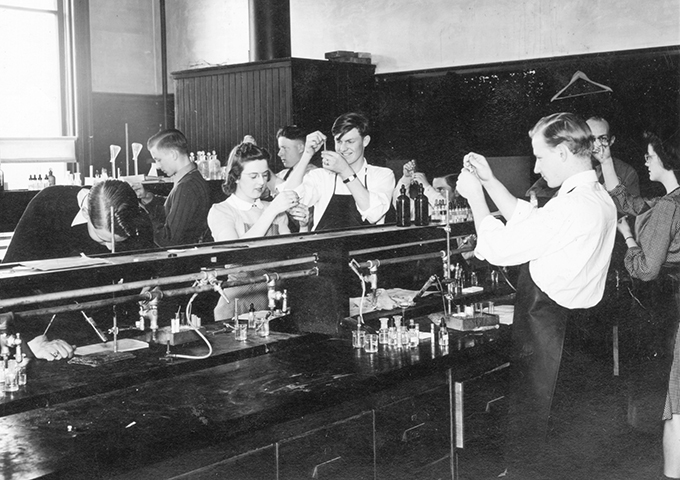
Northwestern College Archives
Northwestern students conduct experiments in a science lab in 1942.
It is hard to pinpoint exactly when Northwestern began to stand out for the strength of its science programs.
Northwestern Classical Academy was established to prepare students for college and ultimately the ministry. However, in 1924 Alfred Popma graduated from the academy, earned his medical degree, and became one of the nation’s foremost authorities on cancer, credited with pioneering breast self-exams for women.
The same year Popma graduated from the academy, Science Hall was built. It contained a single laboratory, two classrooms and an auditorium/gymnasium. Two decades later, Zwemer Hall housed the chemistry, biology and physics labs.
What President Jacob Heemstra described as “insufficient laboratory space for science work” led to construction of an addition to Science Hall in 1948. Two more additions and a name change, to Van Peursem Hall, followed. When the final wing was added in 1968, physics occupied the first floor; biology, the second; and chemistry, the third.
In the years between those additions, Northwestern became a four-year college. It also doubled the number of its biology faculty to two when Dr. Edward Van Eck and Virg Muilenburg ’62 (see page 3) were hired in 1963. Van Eck, recruited to develop a pre-medicine program, taught at NWC for 18 years; Muilenburg, for 37. Other longtime science professors included Dr. Glen Hegstad, biology, 30 years; Dr. Henry Veldhuis ’61, physics, 32 years; and chemistry professors Dr. Harold Hammerstrom, 31 years, Dr. Peter Hansen, 30 years, and Dr. Tim Lubben, 30 years.
Together they provided an education that prepared Northwestern science majors for success in medical and graduate schools. As a sophomore, Linda Van Roekel ’69 received a research grant from the National Science Foundation (NSF), while Doug Schelhaas ’67 won a National Institutes of Health traineeship his senior year that was equivalent to a pre-doctoral fellowship.
Until 1970, all of the college’s premedical students transferred after their initial two years at Northwestern. Jerry Van Es ’71 was the first to be accepted directly from Northwestern. Ruth Langstraat ’72, another NSF grant recipient, was the first female Northwestern graduate to enter medical school.
Other graduates from the ’60s and ’70s pursued careers as research scientists. Hansen, the longtime chemistry professor, cites Northwestern alumni like John Swart ’90, who earned his doctorate in chemistry from the University of Nebraska, and Luke Haverhals ’00, who has a doctorate in chemistry from the University of Iowa (see page 37).
And while Popma was the first recipient of Northwestern’s Alumni of the Year award, he was followed—to date—by 20 other science grads who likewise have been recognized by their alma mater for their professional achievements.
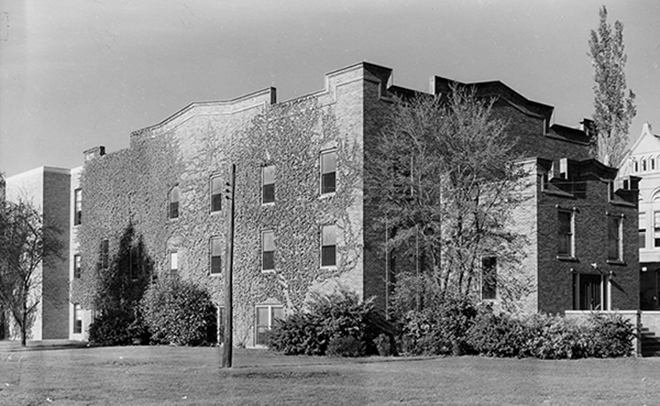
Northwestern College Archives
Science Hall (what is now the west wing of Van Peursem Hall) as it appeared in the 1940s. Note the new addition on the building’s south end and Zwemer Hall on the right.
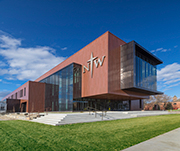 The 61,000 square-foot
DeWitt Family Science Center features large windows to the outdoors and into classrooms and laboratories, making a grand impression on the southwest entrance to campus.
The 61,000 square-foot
DeWitt Family Science Center features large windows to the outdoors and into classrooms and laboratories, making a grand impression on the southwest entrance to campus.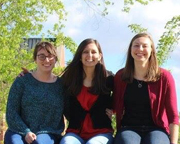 Friendships formed at Northwestern—whether begun at a freshman wing meeting, in a dorm room or at a play rehearsal—often last a lifetime.
Friendships formed at Northwestern—whether begun at a freshman wing meeting, in a dorm room or at a play rehearsal—often last a lifetime.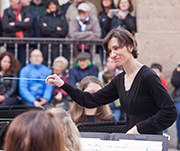 Northwestern’s Symphonic Band presented eight concerts in eight days during a spring break mission tour of Spain.
Northwestern’s Symphonic Band presented eight concerts in eight days during a spring break mission tour of Spain. Due largely to the excellence, commitment and inspiration of longtime faculty, North-western’s science programs earned an exceptional reputation despite operating in modest facilities.
Due largely to the excellence, commitment and inspiration of longtime faculty, North-western’s science programs earned an exceptional reputation despite operating in modest facilities.
Classic Comments
All comments are moderated and need approval from the moderator before they are posted. Comments that include profanity, or personal attacks, or antisocial behavior such as "spamming" or other inappropriate comments or material will be removed from the site. We will take steps to block users who violate any of our terms of use. You are fully responsible for the content that you post. Comments posted do not reflect the views or values of Northwestern College.